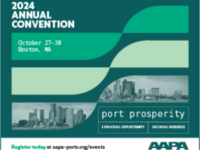Bringing Projects to Life
To grow, seaports have to selectively invest and update. But they can’t do it alone. They call on firms – ranging from global EPCs to small niche contractors – that specialize in helping bring port capital projects to fruition.
* By Lori Musser *
To grow, seaports have to selectively invest and update. Whether ports are deepening waterways, building capacity, enhancing safety or improving inland connectivity, they can’t do it alone. They call in the consulting and contracting community.
Seaports bring capital projects to life with the help of firms specializing in architecture, design, engineering, procurement, construction, and even operations and maintenance. These companies range from global engineering, procurement and construction firms (EPCs), to small niche contractors. The one thing they have in common is a skill set that will help bring port capital projects to fruition.
There are evolving options for project delivery. Often, seaports undertake a two-stage process, first designing and then bidding out the “build” portion of a project. If they want a single-point-of-responsibility contract, they may choose to go a design-build route, which can minimize risks and expedite delivery by overlapping design and construction phases.
Shortening delivery is particularly apropos after a natural disaster. Tim Murphy is deputy district engineer for programs and project management with the U.S. Army Corps of Engineers, Jacksonville District. He recalled an urgent situation in Puerto Rico after Hurricane Maria in 2017. He said, “We found active flooding in Yauco on the southern coast. A winding river jumped its banks and carved a new channel through the middle of town. We assessed the problem, figured out a solution over the weekend, developed plans and specs, awarded a contract theext day and had the contractor working on Tuesday.”
Choosing an appropriate project delivery method is largely driven by project complexity, schedule, expectations and risks.
Ports invest heavily in infrastructure. Bruce Laurion, vice president of engineering for Port Tampa Bay, said the key to negotiating optimal project contracts is the use of a competitive procurement process. He emphasized that making firms aware of the solicitation is critical to ensure a good level of interest and response. Even the best process won’t produce results if the contracting community isn’t aware of the opportunity.





